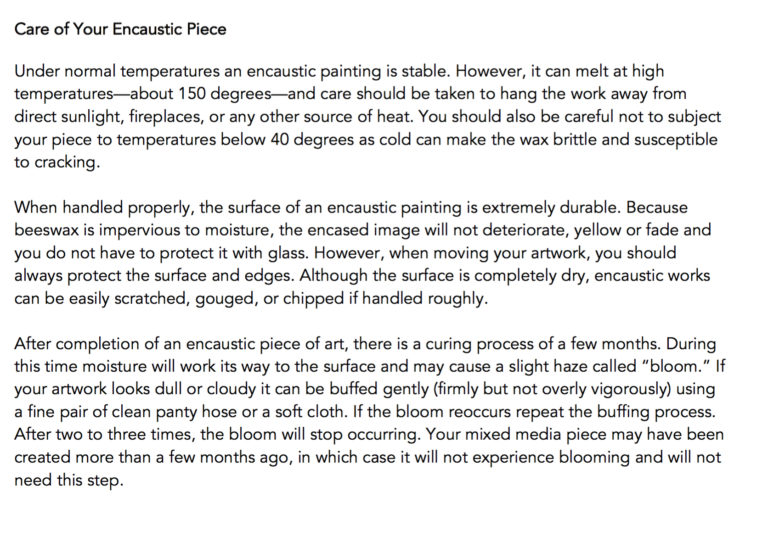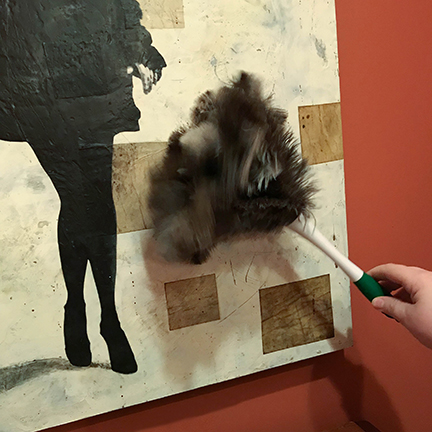Caring for Your Photo Encaustic piece.
It came up recently in my alumni FB group about how to care for encaustics, so I thought I’d share some of my insights and give you a sample of what I provide for my collectors.
But first of all. Caring for your encaustic starts with you and the work should be cared for just like any other fine art piece. Upon completion, store your work. Wrap the piece in wax paper, or glycine wrap or a similar product that will not scratch the surface. Bubble wrap the piece (be sure that the bubble wrap is not coming in direct contact with the wax and that the bubbles are facing outwards so they don’t make imprints in your work), and store in a safe, temperature controlled (between 40 and 80 degrees Fahrenheit) place.
Encaustics are not quite mainstream and many people are new to the medium. They might have no idea what encaustic is or how to treat the work. So many people have never been introduced to the medium until they see your piece.
There is no right way to do this, but I highly suggest that you provide some information along with your work when it is sold, donated, or gifted to someone who will be hanging it on their walls and enjoying it.
At the very least I suggest that you tell the person owning your work how to care for the piece. Collectors will always ask, “will it melt?” So, I would strongly suggest that you address that concern right off the bat. As you know, encaustic pieces can be fragile if mishandled and you’ll want your buyer to know how to take the best care of your piece.
Things you might want to consider mentioning.
- Materials used (beeswax, encaustic, photography, oil paints, graphite, etc.)
- Explaining your process and how it was made
- Who owns the copyright? Or maybe that you reserve the right to use the same photo (or partial photo) in another work of art?
- Why the work isn’t protected by glass.
- How to protect the surface and the edges when moving
- That they are fragile in that the surface can be scratched, gouged or chipped
- The archivalness of the work
- Transporting the painting in hot and cold climates
- The history of encaustic
- How to hang the work
- What to do if they damage the texture or chip the edges of the piece
- The curing process and how to handle ‘bloom’ if it occurs
- How to clean the artwork
- If your piece has a high buff finish, you might want to tell them how to maintain this finish.
You are the artist and it’s completely up to you how you want to handle your “Care for Encaustics” information. Here is a copy of what I provide with all my artwork.

Tell me what you tell your collectors, galleries, or buyers about your work? Let me know in the comments below.
Be well….be creative,

I advise anyone who’s going to clean/polish a piece of my work to take off any jewellery and their watch to avoid scratching the surface as I’ve mistakenly done it myself a few times. I put a little sticker with care instructions on the back of my work, hoping it helps to remind them how (plus it has my contact info on it!). Thanks, Clare, for another useful blog
Great tip Cinnamon…..I remember someone once running her hands across one of my pieces and the back of her ring totally gouged the piece…..that was before I started to us a lot of texture in my work and I couldn’t believe she did that. Now with all the texture you wouldn’t even notice.
Thanks for all the great info Clare. I always attach a note on the back of my artwork with information about how to handle encaustic pieces.
You are very welcome Irene:)